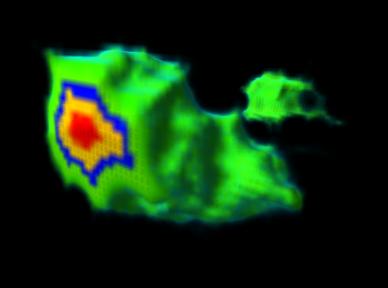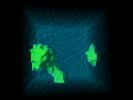
Francis W. Starr and H. Eugene Stanley
Department of Physics, Center for Polymer Studies, and Center for Computational Science
Boston University
Understanding the anomalous properties of liquid water is a long studied problem. Recent work indicates that the behavior of stretched and supercooled water may hold the keys to understanding the known anomalies at ambient temperatures and pressures. Here we present a molecular dynamics simulation of 8000 molecules at a large negative pressure that causes cavitation. The absence of this catastrophic event in smaller simulations (fewer molecules) emphasizes the need for large systems to study the properties of stretched water.
Video Sequence

Video Sequence: RGB
The molecular dynamics simulation depicts cavitation of 8000 water molecules interacting via the SPC/E potential. The system is equilibrating to a temperature of 300K and extremely stretched pressure of -100MPa. The simulation covers roughly 100ps of real time.
Hardware: 192 processor SGI/Cray Origin 2000
Software: C, MPI, native shared memory libraries. Visualization done using AVS.
Graphics programming and video production: Graphics programming by Erik Brisson; visualization and video production by Kathleen Curry, Scientific Computing and Visualization Group, Boston University.
Acknowledgments: We thank M.C. Bellissent-Funel, S. Harrington, J. Nielsen, P. Poole, S. Sastry, and F. Sciortino for helpful discussions and the Scientific Computing and Visualization group at BU for visualization. FS also thanks C. Rebbi and R. Giles for their support. FS is supported by an NSF fellowship; the Center for Polymer Studies is supported by the NSF and British Petroleum.
